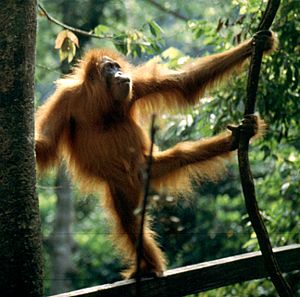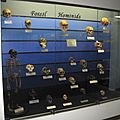Hominid facts for kids

-
- For a full account of the biological family, see Hominidae
A hominid is any member of the biological family Hominidae. These are the "great apes", living and extinct. At present there are humans, chimpanzees, gorillas and orangutans.
The word "hominid" has been used in various ways. The classification of the great apes has been revised several times in the last few decades. These revisions led to different uses of the word "hominid". The original meaning of the taxon Hominidae meant only humans and their closest relatives. Now this group is called the Hominina.
The primatological term hominid is easily confused with a number of very similar words:
- A hominoid or ape is a member of the superfamily Hominoidea: existing members are the lesser apes (gibbons) and great apes.
- A hominid is a member of the family Hominidae: all of the great apes.
- A hominine is a member of the subfamily Homininae: gorillas, chimpanzees, humans (excludes orangutans).
- A hominin is a member of the tribe Hominini: including humans.
- A hominan is a little used term for a sub-tribe. It is only used by people who put chimpanzees in the Hominini.
- A human is a member of Homo sapiens. The word is sometimes also used to refer to any extinct member of the genus Homo or members from other hominan genera.
- A humanoid is a vaguely human-shaped entity; the term is typically used in science fiction.
The dispute is really about whether humans and Australopithecines are sufficiently different from chimpanzees to rank as a separate family.
In morphology and life style they are, in genetics they are not. A move from rainforest to savannah and woodland led first to bipedalism (walking on two feet). Later, hunting and social needs led to larger brains brains and the making and use of tools. These differences between human beings and the other great apes are certainly important. However, a genetically based taxonomic classification shows the genetic differences are not enough to divide us into separate families. Genetics, rather than morphology, is more widely accepted as the critical standard. Many scientists, including anthropologists, use the term "hominid" to mean humans and their direct and near-direct bipedal ancestors.
Images for kids
-
Humans are one of the four extant hominid genera.
-
A model of a modern human hominid skull (or hominin skull)
-
A fossil hominid exhibit at The Museum of Osteology, Oklahoma City, Oklahoma
-
Replica of the skull sometimes known as "Nutcracker Man", found by Mary Leakey.
See also
 In Spanish: Homínidos para niños
In Spanish: Homínidos para niños






